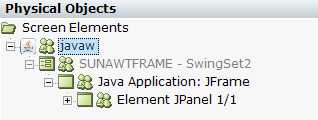Using the Java Native Connector
The Java Native Connector, introduced in APA 7.3, enables you develop solutions that interact with all kinds of Java applications, including Oracle forms. From APA 7.6, the Java Native connector also supports IBM Java Machine (1.1 and up).
Projects created with the Former Java Connector are not supported by the Java Native Connector. If you need to work with these projects, disable the Java Native Connector, and then enable the Former Java Connector from the System Settings, as described in Enabling Connectors and Extensions.
Capturing Java Native Screen Elements
The process for capturing screen elements with the Java Native Connector is the same as the process for capturing other types of screen elements, as described in Capturing Screen Elements.
Understanding the Java Native Object Hierarchy
The Java Native object hierarchy is automatically created as you capture Java Native screen elements. The tree conforms to the object filtering received from the Java Mapper, with the following additional physical objects added at the top of the hierarchy:
-
The root screen element is a Process screen element, for example javaw in the tree below.
-
The next level is the Win32 Form screen element, which is the parent to the rest of the screen elements, for example SUNAWFRAME in the tree below.
-
The third level is the main Java frame, which is a JN Frame screen element, for example Java Application in the tree below.

Locating Java Native Screen Elements
The process for locating screen elements captured with the Java Native Connector is the same as the process for locating other types of screen elements, as described in Locating Screen Elements.
Recapturing Java Native Screen Elements
The process for recapturing screen elements with the Java Native Connector is the same as the process for recapturing other types of screen elements, as described in Recapturing Screen Elements.
